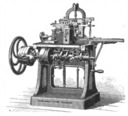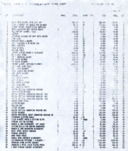The Barth type casting machine was developed in the late 1880s by Ernst Lietze and Henry Barth of the Cincinnati Type Foundry, based on earlier machines primarily by Foucher. After the amalgamation of American Type Founders in 1892, it spread to the various constituent foundries of the firm, and after the consolidation of the foundries into a single location in New Jersey it became the only style of non-pivotal type caster used by ATF.
Barth casters were probably sold in small numbers to other foundries by the Cincinnati Type Foundry before the amalgamation of ATF, although as yet we have no details of these sales. After the forming of ATF, they were never sold commercially in the US and only a very few were sold abroad.
A few Barths survive today, and some of these are operational or near-operational. Although the story of the Barth caster for the last several decades has been one of great loss, it is likely that it actually has the best survival rate of any type casting machine (for casting single types for the cases). Perhaps eight percent (or more) of the machines made survive. This is either encouraging or depressing, depending on your mood and perspective. (See the subsection on Relative Survival Rates in the Census of Barth Type Casters, below, for a discussion of this.)

The Barth Type Caster Before ATF
[Development.] [Use at Cincinnati, 1886-1892.] Sales to other foundries, 1886-1892.

Sales Abroad by ATF
[NOT DONE] To the best of my knowledge, ATF never sold a Barth caster to another domestic foundry. They did, however, sell several machines abroad: to Stephenson, Blake in the 1930s and to Typefoundry Amsterdam in the 1940s.
[To Do: Evaluate claim that Stephenson, Blake purchased a No. 4 Barthe [sic] from "the Western Type Foundry" in 1902, and then a No. 3 in 1903. In Millington, Stephenson Blake, p. 94.]

A Census of Barth Type Casters
Including a reprint of the 1993 ATF auction results.

Other Casters at ATF
[INCOMPLETE] ATF would have liked you to believe that all of their type was cast on Barths. This was never so. Pivotal casters played an important role to the end, and spacing material was cast on the Ziegler machines (which were designed originally as complete type casters). Additionally, ATF acquired and scrapped an unknown number of non-pivotal casters from constituent and acquired foundries.
All portions of this document not noted otherwise are Copyright © 2014-2015, 2018, 2022 by David M. MacMillan.
Circuitous Root is a Registered Trademark of David M. MacMillan.
This work is licensed under the Creative Commons "Attribution - ShareAlike" license, version 4.0 International. See http://creativecommons.org/licenses/by-sa/4.0/ for its terms.
Presented originally by Circuitous Root®